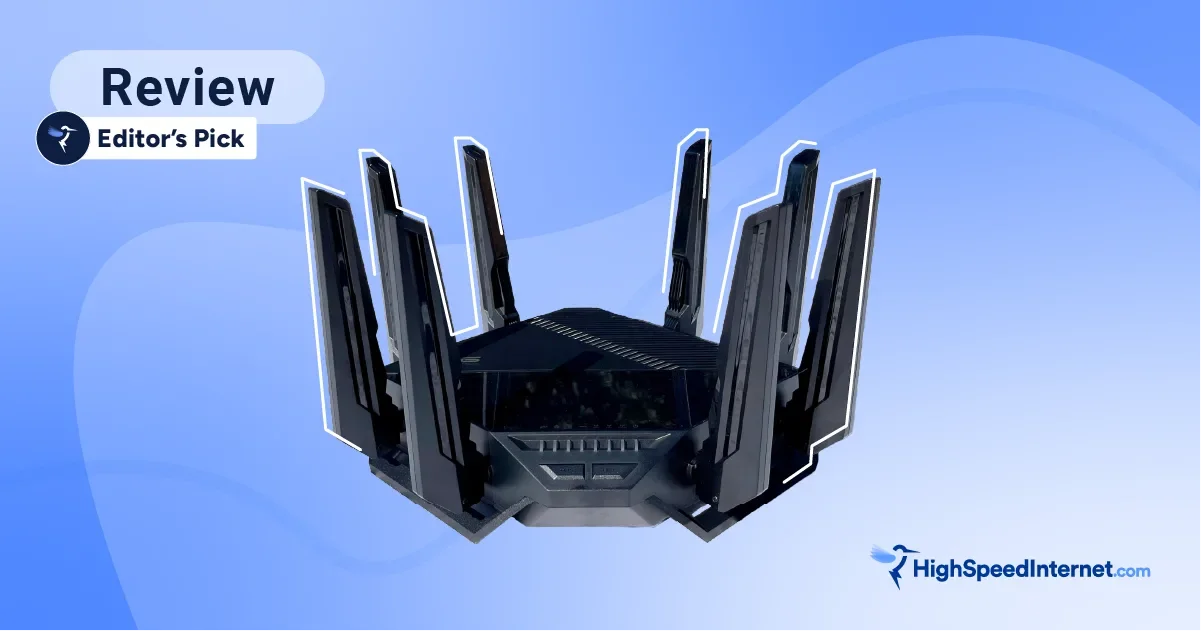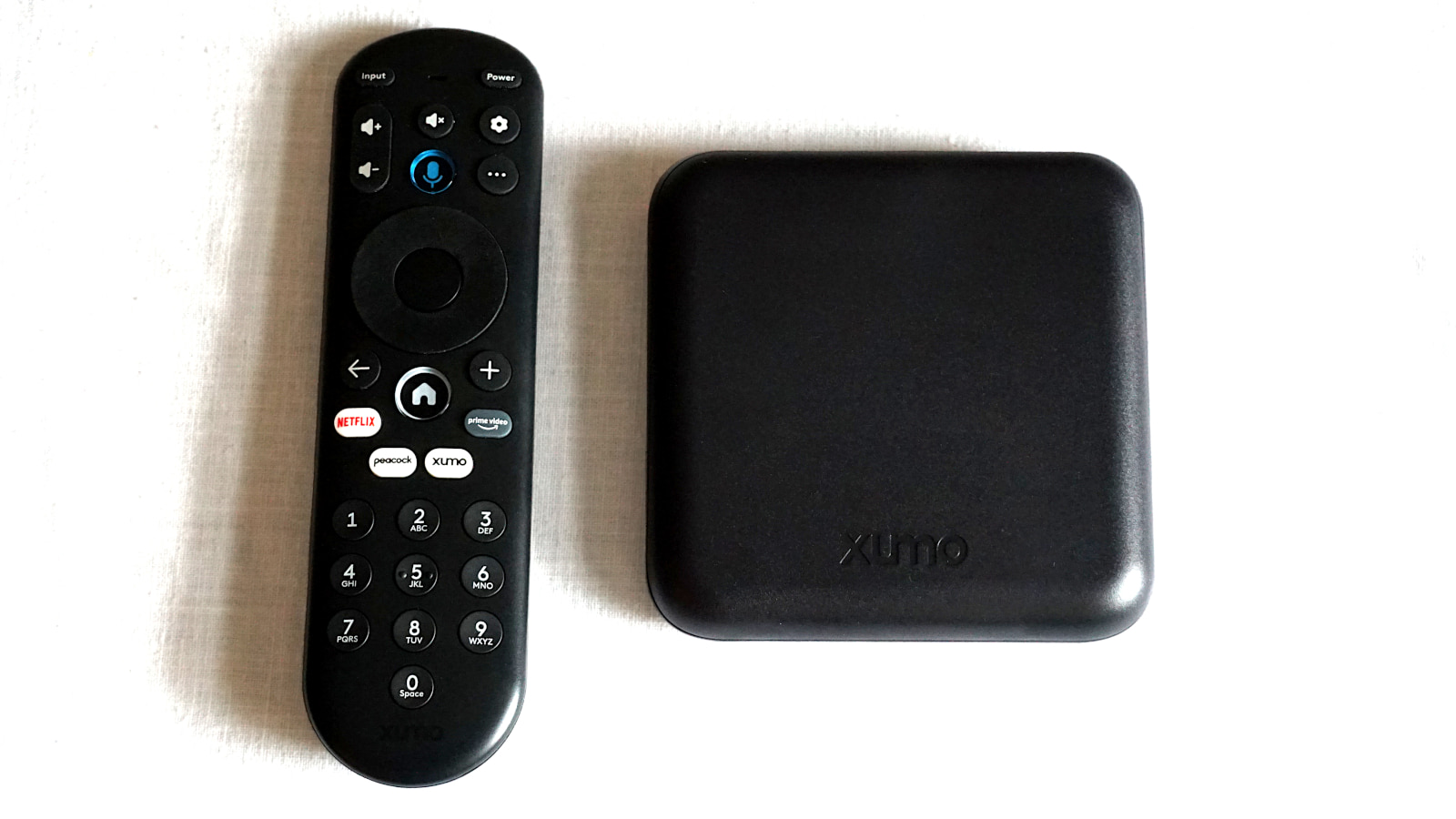Our Router Selection Methodology
See how we select the best Wi-Fi routers based on our hands-on testing
Jun 28, 2025 | Share
Equipment Guides, Product Reviews, Router Reviews
Unless you’re a hardcore home networking expert, selecting the best router or mesh system for your home or business can be a real pain. Maybe you don’t want to be bothered with the details, and you’d rather someone else pick it for you. Boom! That’s where our router roundups come in.
But how do we choose these things? What do we look for when we select the best routers? Read on to understand our methodology and to get a glimpse into how we test routers and mesh systems.
In this methodology:
Residential routers | Business routers and access points | How we test routers and access points
In this methodology:
What we look for in a router or mesh system
Our roundups are based on products we receive and test. We record the specs, features, and benchmarks in a database and then compare them to decide what’s best for a specific use case. Obviously, that’s not something the average consumer can or wants to do, so we composed a list of specs and features we think you should consider when you shop for a standalone router or mesh system.
Wi-Fi type
Currently, there are three versions of Wi-Fi out in the wild: Wi-Fi 6, Wi-Fi 6E, and Wi-Fi 7.
Wi-Fi 7 is the latest specification as of 2025. The number of devices and routers supporting it is growing, but that doesn’t mean you have to jump on the Wi-Fi 7 bandwagon right away (although our tests say you should).
Most modern Wi-Fi devices, like smartphones, tablets, and laptops, support Wi-Fi 6 or Wi-Fi 6E, both of which are backward compatible. The only difference between the two is that the latter adds the 6 GHz band. But now that Wi-Fi 7 routers are available, which also includes the new 6 GHz band, getting a Wi-Fi 6E model is kinda pointless.
Here are some comparisons:
Bottom line: We gravitate to the latest specifications.
WAN port(s)
When shopping for a router, pay close attention to the WAN port to make sure it’s compatible with the internet speed you have now or plan to get in the future.
For example, if you have a 2,000Mbps (2Gbps) internet plan, you don’t want a router with a Gigabit Ethernet port—you’re automatically cutting out half the speed you’re paying for each month. No one likes a half-full cup of french fries, right?
Likewise, a 2.5 Gigabit Ethernet port is overkill if you never plan to upgrade your internet speed beyond 900Mbps. However, if you have a keen eye set on an awesome budget-friendly Wi-Fi 7 router and it’s packing a 2.5 Gigabit Ethernet port, there’s no reason to shop elsewhere—the overkill gets a thumbs up in our book.
Shown in the table below are the real-world speeds of the most commonly-used Ethernet ports after factoring in networking overhead, which in this case is data used to transmit your usable data, or “payload.” Take a look:
| Port type | Max real-world speed* | Best for |
|---|---|---|
| Gigabit Ethernet | 940Mbps | Cable, fiber |
| 2.5 Gigabit Ethernet | 2,350Mbps | Cable, fiber |
| 5 Gigabit Ethernet | 4,700Mbps | Fiber |
| 10 Gigabit Ethernet | 9,400Mbps | Fiber |
* Determined using a 6% overhead
Some routers have multiple Ethernet ports you can use for internet. For example, we’ve seen routers that have a 2.5 Gigabit Ethernet port and a Gigabit Ethernet port—you must choose one or the other.
Bonus: Link aggregation
Link aggregation allows you to pair two Gigabit Ethernet ports to create one 2Gbps connection. Some routers allow you to do this for internet, but it’s only worth using if your modem or ONT has two Gigabit Ethernet ports that support it.
Other routers let you pair two Gigabit Ethernet ports for a 2Gbps connection to a wired device, like a network-attached storage unit. Some desktops and laptops support link aggregation, too, especially ones designed for gaming.
Bottom line: We prefer the fastest WAN port possible if it doesn’t jack up the price. Link aggregation is cool to have, but only if you have devices that support it.
Bands
Every router we’ve tested includes:
- 1x 2.4 GHz Wi-Fi radio
- 1x 5 GHz Wi-Fi radio
To better balance your home network load, try to shoot for a router or mesh system with three radios instead of two, preferably:
- 1x 2.4 GHz Wi-Fi radio
- 1x 5 GHz Wi-Fi radio
- 1x 6 GHz Wi-Fi radio
The 6 GHz spectrum is new territory, so it’s nowhere near as congested as the 2.4 GHz and 5 GHz bands. However, it’s only available to Wi-Fi 6E and Wi-Fi 7 devices, so be sure you have (or plan to have) compatible devices before you upgrade to a router packing this new connection.
Alternatively, if Wi-Fi 6E and Wi-Fi 7 aren’t on your upgrade list quite yet, you can always go with a router with the following three-radio setup:
- 1x 2.4 GHz Wi-Fi radio
- 1x 5 GHz Wi-Fi radio (low band)
- 1x 5 GHz Wi-Fi radio (high band)
Three-band routers and mesh systems are more expensive than two-band ones, so keep that in mind.
Bottom line: More connections are better but generally more expensive.
Max throughput
The max throughput tells you how much data a router can transmit to your devices at one time. Manufacturers combine the maximum throughput of all bands and list a single impressive digit. You’ll even see the number crammed into the model number, like AX11000, which translates to a Wi-Fi 6 (802.11ax) router with an 11,000Mbps throughput. Clever.
Let’s use the NETGEAR Nighthawk RS700S as an example:
| Band | Maximum bandwidth |
|---|---|
| 2.4 GHz | 1,400Mbps |
| 5 GHz | 5,800Mbps |
| 6 GHz | 11,500Mbps |
| Total | 18,700Mbps |
NETGEAR rounds the total up to 19,000Mbps, but you see how it works. One device will never use that total throughput because the advertised number is the culmination of three bands.
You want a high throughput for the two following reasons.
Wi-Fi speeds degrade over distance
Routers generally have more Wi-Fi bandwidth than what their WAN ports can deliver to accommodate for overhead and distance. You automatically lose some speed when the router translates data from wired to wireless, and then it struggles to push data quickly through the sea of interference flooding your area. Tack on distance, and all the extra bandwidth gets used or lost. So, while your device may support more Wi-Fi speed than your internet plan, you may see a quarter of that speed at 120 feet.
More devices need more bandwidth
You need more Wi-Fi bandwidth to handle a large number of devices. The average household has at least 20 devices that ping the internet, so you need a large throughput to handle all that traffic. Your speeds will feel super-slow if all those devices are pinging a router with a low 1,300Mbps throughput.
Bottom line: More throughput is better, but it’s usually more expensive.
Stream count
Stream count ties into the max throughput, as the number of streams a router supports tells us the total throughput and how many devices the router can handle in any given second. Technically, a router can support dozens or more devices, depending on the model, but the number of devices it can talk to at once gives us an idea of how well the router will perform.
Let’s look at the Nighthawk RS700S again:
| Stream count | Maximum bandwidth | |
|---|---|---|
| 2.4 GHz | 4 x 350Mbps* | 1,400Mbps |
| 5 GHz | 4 x 1,450Mbps† | 5,800Mbps |
| 6 GHz | 4 x 2,875Mbps‡ | 11,500Mbps |
| Total | 12 | 18,700Mbps |
* Using a 40 MHz channel and 4096-QAM
† Using 160 MHz channels and 4096-QAM
‡ Using 320 MHz channels and 4096-QAM
Generally, Wi-Fi client devices support two incoming and two outgoing (2×2) streams—some desktops and adapters can support more. You want a router with more than two streams per band to reduce latency and congestion.
In the example above, the RS700S can transmit to six Wi-Fi devices simultaneously at their full speed or to 12 devices at half their speed. All additional devices must wait in line for their turn, causing latency.
Bottom line: More streams are better, but it’s usually more expensive.
LAN ports
The number of LAN ports isn’t something to look for if you rarely use Ethernet. Most standalone routers come with four Ethernet ports you can use, while mesh systems generally have two Ethernet ports: one for wired networking and one for internet. We’ve seen gaming routers with eight LAN ports!
Bottom line: Multiple LAN ports are good to have if you use lots of wired devices.
Features
This section is a little loaded, but it’s also how we compare routers in the database and assign scores. We like a lot of bang for our buck—we bet you do, too.
Mesh support
To combat the rise of mesh networking systems like Eero, many standalone routers and gateways now support EasyMesh, an open-source specification that allows gateways, routers, extenders, and adapters to mesh together without requiring a specific brand. Thanks to EasyMesh, you can buy four affordable, high-powered routers and create a mesh network that’s cheaper and better than a four-piece mesh kit.
Security
We usually suggest routers with free security, like AiProtect from ASUS and TP-Link’s HomeCare, that offer features like free malware protection. Other routers offer minimal security and parental controls while locking premium features behind a monthly subscription. Decide what’s best for your long-term budget before you invest.
VPN
Many routers now include VPN connectivity. For example, you can surf anonymously from a coffee shop, as your data is directed to the VPN server in your home router first before it reaches the destination. Some routers have a built-in VPN client to protect devices that don’t support VPN software, like game consoles or media streamers.
In both cases, you normally don’t need a VPN subscription service. However, some manufacturers charge for using these services, so keep an eye out for the free versions when you shop for a new router or mesh system.
Parental controls
The more parental controls you can get for free, the better. After all, you’ve already invested a lot into a device that will probably be obsolete within five years. Why pay more than you have to?
Generally, parental controls rely on profiles you create for all users. After that, you set the age range and assign the devices. What you get for free depends on the manufacturer, as filters, custom bedtimes, and internet downtimes are usually premium features, especially on mesh systems.
USB connectivity
Routers with USB ports seem to have discontinued printer sharing, given you can now share printers via Wi-Fi and the cloud. But you can use a USB port to share files across your local network, set up a local or public FTP server, and stream media you own to media players. Some routers also support Apple Time Machine, allowing you to back up your Mac to the connected USB drive.
Game-specific
Here are a couple features wecall out when we evaluate gaming routers.
Tools: While any manufacturer can dress up a router and call it a gaming product, few routers include custom tools for gaming. NETGEAR’s Geo-Fencing tool on the Nighthawk XR1000 is a great example of a tool designed specifically for gamers—it allows you to limit your connections to gaming servers within a custom shape you draw. The Ping Heatmap tool allows you to ping specific game servers to find the one with the lowest latency.
Bling: Bling isn’t a requirement, but it sure makes a statement. Alienware, ASUS, HP, MSI—they all push some type of bling, so everyone knows you’re a gamer. Even the ASUS ROG phone shines the RGB logo on the back like an eye. Why shouldn’t your gaming router sparkle and dazzle onlookers, too? MSI’s RadiX AXE6600 is a good example of some fun bling to have!
Bottom line: A long list of features is great if the price doesn’t break the bank.
Design
A router’s overall design dictates how it performs, from the router’s actual size to the antennas it uses.
Form factor
Yes, the overall size of a router affects its performance and range. Why? Because you need a powerful CPU to deliver the top speeds at the longest range possible. You also need plenty of system memory for the CPU to use as a scratchpad while it manages the firmware, antennas, and other router components. Bigger processors and added memory generate more heat and require more ventilation. Small routers can’t output the same speeds at a long range as the larger ones.
Antennas
Technically, you only need one antenna per band, but routers almost always use multiple antennas for each one. The more you have, the better.
External antennas radiate signals in mostly one direction perpendicular to their position. Their coverage is more like a donut or an oval if they’re all upright. This design gives you a long horizontal range but less vertical coverage.
In contrast, internal antennas are usually positioned horizontally and vertically, creating a sphere around the router. This design gives you less horizontal range but providers more coverage in every direction.
Mesh kit setup
Some mesh systems ship with multiple compact routers. Other systems ship with one compact router and even smaller satellite units. You generally get better Wi-Fi coverage, multi-device support, and additional wired connectivity with an all-router kit, but they are rather pricey compared to the router-satellite kits. Consider what you need for your wired and wireless devices before investing.
Bottom line: The bigger the router, the more powerful it is. Go with external antennas if you want long range. Stick with an all-router kit if you want a powerful mesh system.
What to look for in a business router or access point
Nearly every business-oriented router and access point we’ve tested lacks the features we commonly associate with home routers. So, what are the standout features you should consider when purchasing a router or access point for your business? We list a few.
Security
Security should be first on your list. Features like malware prevention, intrusion prevention, and mail fraud prevention are great to have, but they’re best when offered for free with your equipment. Having a thorough firewall is great, too, but be mindful of the potential speed reduction.
Power over Ethernet
Power over Ethernet (PoE) is essential for installing access points in places that generally don’t have electrical outlets, like on ceilings. These devices receive power and data over Ethernet, but they can’t transmit power. To supply power to all your access points, you must use a PoE-compatible switch or several power injector adapters.
VLAN support
You want a router or access point that supports virtual networking. This feature allows you to separate traffic, preventing customers from directly accessing your Point of Sale devices or internal data servers. VLAN tagging is also helpful in preventing curious employees from virtually snooping around in other departments and accessing sensitive data.
Failover support
Failover is handy when an access point loses its direct connection to the network’s main gateway. When this happens, the access point reroutes data through another access point installed nearby until its connection to the gateway is restored.
How we test routers
We test router speed by setting up each router in an office and connecting it to a local test server running speed-test software. By using our own local server and software, we can control the input versus relying on fluctuating speeds caused by the connection between us and a remote test server. Routers aren’t internet equipment, so we exclude the internet from testing.
Once we connect the router to our local server, we transmit test data between our wireless devices and the server, taking numerous measurements to account for fluctuations in Wi-Fi speeds. Here’s the testing path:
Wi-Fi client → router → local wired server → router → Wi-Fi client
The first tests occur close to the router, without obstructions—so the Wi-Fi is as strong and fast as it gets. We repeat the process straight out at 10, 20, and 30 feet, with only a glass door obstructing our view of the router. The same glass door and an exterior door blocks our path when we test outside at 40 and 120 feet.
We also run tests in a hallway to the left of the TV room and office—where there’s a glass door, three walls, and an air handler unit blocking our view of the router. The dining room, another testing point, sits to the right of the kitchen, TV room, and office—two walls and a glass door block the path in this test.
Client devices used in testing
We’ve used four different client devices in our router tests over the years. Here are their specifications.
Current test clients
| OnePlus 11 5G | Google Pixel 6 | |
|---|---|---|
| Wi-Fi specification | Wi-Fi 7 | Wi-Fi 6E |
| Stream configuration | 2 x 2 | 2 x 2 |
| Max 6 GHz speed (BE) | 5,764Mbps | – |
| Max 6 GHz speed (AXE) | – | 2,404Mbps |
| Max 5 GHz speed (BE) | 2,882Mbps | – |
| Max 5 GHz speed (AX) | 2,402Mbps | 2,402Mbps |
| Max 5 GHz speed (AC) | 866Mbps | 866Mbps |
| Max 2.4 GHz speed (BE) | 688Mbps | – |
| Max 2.4 GHz speed (AX) | 574Mbps | 286Mbps |
| Max 2.4 GHz speed (N) | 144Mbps | 144Mbps |
We purchased the Google Pixel 6 to test Wi-Fi 6E prior to the availability of Wi-Fi 7 client devices. We now use a OnePlus 11 5G to test Wi-Fi 7 routers and mesh systems.
Discontinued test clients
| iPhone 12 Pro Max | Google Pixel 3 | |
|---|---|---|
| Wi-Fi specification | Wi-Fi 6 | Wi-Fi 5 |
| Stream configuration | 2 x 2 | 2 x 2 |
| Max 5 GHz speed (AX) | 1,200Mbps | – |
| Max 5 GHz speed (AC) | 866Mbps | 866Mbps |
| Max 2.4 GHz speed (AX) | 195Mbps | – |
| Max 2.4 GHz speed (N) | 144Mbps | 144Mbps |
We stopped using the Google Pixel 3 to test routers, as it’s a Wi-Fi 5 device and stopped receiving firmware updates from Google. Wi-Fi 5 is ancient history anyway, so it’s not worth testing in 2025.
We also stopped using the iPhone 12 Pro Max, given its age.
Author - Kevin Parrish
Kevin Parrish has more than a decade of experience working as a writer, editor, and product tester. He began writing about computer hardware and soon branched out to other devices and services such as networking equipment, phones and tablets, game consoles, and other internet-connected devices. His work has appeared in Tom’s Hardware, Tom's Guide, Maximum PC, Digital Trends, Android Authority, How-To Geek, Lifewire, and others. At HighSpeedInternet.com, he focuses on network equipment testing and review.
Editor - Jessica Brooksby
Jessica loves bringing her passion for the written word and her love of tech into one space at HighSpeedInternet.com. She works with the team’s writers to revise strong, user-focused content so every reader can find the tech that works for them. Jessica has a bachelor’s degree in English from Utah Valley University and seven years of creative and editorial experience. Outside of work, she spends her time gaming, reading, painting, and buying an excessive amount of Legend of Zelda merchandise.



